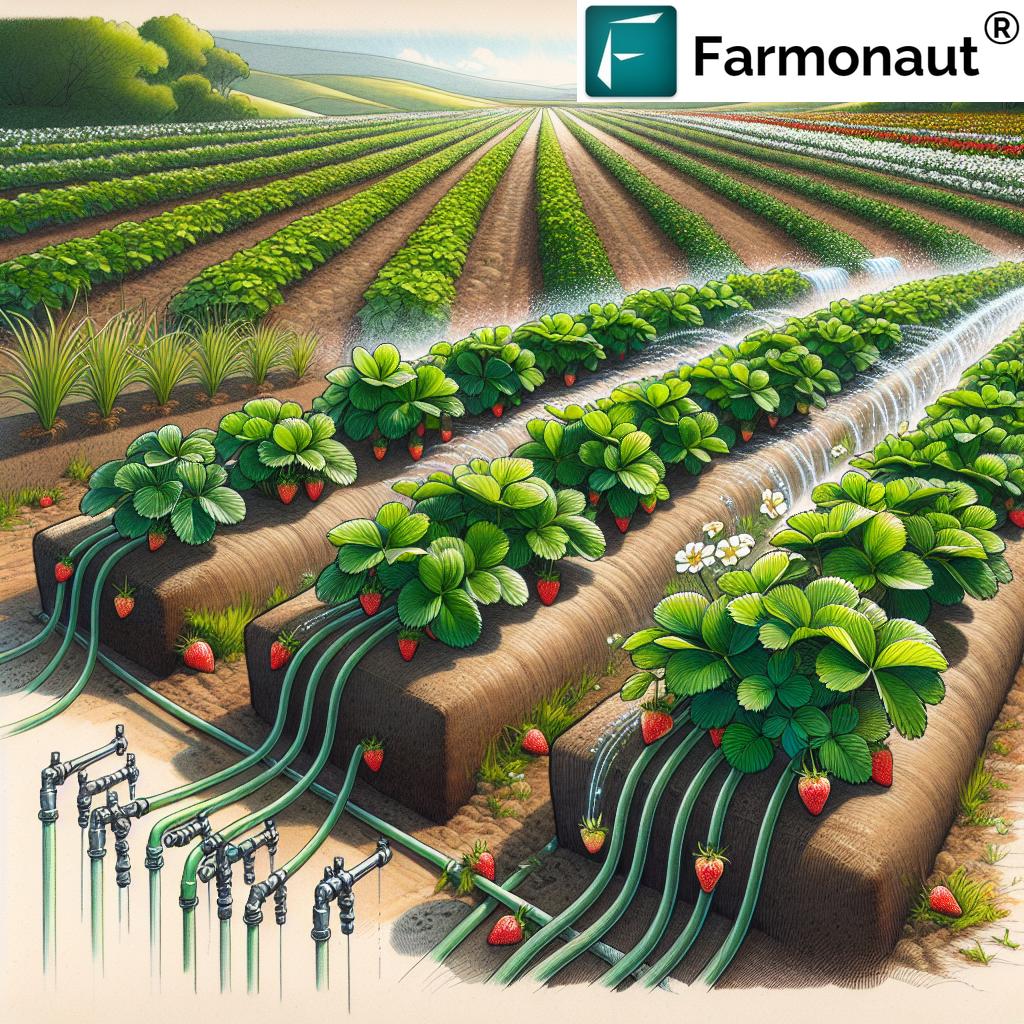Sustainable Strawberries: 7 Key California Innovations
“California produces nearly 90% of U.S. strawberries using advanced water-saving and soil health innovations.”
Table of Contents
- Introduction: The Modern Need for Sustainable Strawberry Farming
- Environmental Challenges in Strawberry Cultivation
- 7 Key Innovations Driving Sustainable Strawberry Farming in California
- 1. Organic Strawberry Production
- 2. Integrated Pest Management in Strawberries (IPM)
- 3. Soil Health Management for Strawberries
- 4. Efficient Irrigation Systems for Strawberry Farms
- 5. Strawberry Crop Rotation & Diversification
- 6. Technological Innovations in Strawberry Farming
- 7. Data-Driven Yield Forecasting for Strawberries
- Comparative Innovations Impact Table
- Economic & Social Benefits of Sustainable Strawberry Farming
- Precision Solutions: How Farmonaut Empowers Sustainability
- Actionable Tips: Transitioning to Sustainable Strawberry Practices
- Frequently Asked Questions (FAQ)
- Conclusion
Introduction: The Modern Need for Sustainable Strawberry Farming
Strawberries are more than just a delicious summertime treat—they symbolize our connection to the land, seasons, and sustainable agricultural practices. As we cultivate this beloved fruit, especially in California (the heart of U.S. strawberry production), we face critical environmental challenges but also remarkable opportunities.
In recent years, sustainable strawberry farming has become essential. Why? Because traditional methods—often reliant on chemical fertilizers, intensive water usage, and monoculture cropping—threaten soil health, water resources, and biodiversity, while also exposing farms to economic risks.
The transformation of strawberry farming in California is a story of resilience and innovation. As we adopt eco-friendly cultivation practices, embrace advanced soil and water management systems, and integrate game-changing technologies, we unlock the full potential of strawberry production for today and future generations. Our journey covers key innovations revolutionizing strawberry farming, the vital role of data and technology, and actionable practices that enable us all to cultivate strawberries profitably, sustainably, and responsibly.
“Organic strawberry acreage in California has increased by over 50% in the past decade due to sustainable practices.”
Environmental Challenges in Strawberry Cultivation
Before we celebrate the success of sustainable strawberry farming, we must understand the core challenges in traditional production systems, particularly in California:
- Soil Degradation: Excessive tilling, chemical fertilizers, and pesticides disrupt soil microbial activity, reduce organic matter, and impair fertility.
- Water Usage: Strawberries require significant irrigation, often leading to inefficient water usage, groundwater depletion, and higher costs.
- Pest & Disease Pressure: Heavy reliance on synthetic chemical controls can cause pest resistance, contaminate soil and water, and damage beneficial biodiversity.
- Greenhouse Gas Emissions: Intensive inputs and machinery drive greenhouse gas emissions, accelerating climate change impacts.
- Loss of Biodiversity: Traditional monocultures diminish on-farm diversity, reducing resilience and ecosystem services essential for long-term yield stability.
Overcoming these challenges is the key to a profitable, environmentally friendly, and resilient approach to strawberry production. Let us explore how innovative practices and technologies are paving the way forward, with particular focus on California’s groundbreaking success.
7 Key Innovations Driving Sustainable Strawberry Farming in California
California is home to some of the world’s most advanced and ecologically sound strawberry cultivation practices. The following seven innovations are reshaping the strawberry landscape in California, significantly improving environmental impacts and economic outcomes.
1. Organic Strawberry Production: Cultivating with Nature
Organic methods are central to sustainable strawberry farming. This approach eliminates synthetic chemicals and pesticides, instead relying on natural alternatives and systems thinking:
- Crop rotations and trap crops disrupt pest and disease cycles.
- Use of natural predators (like ladybugs and predatory mites) for biological pest control.
- Application of compost and organic fertilizers to enhance soil nutrient content and microbial activity.
- Manual weed and pest management, reducing reliance on toxins that can contaminate the environment.
The rise in organic acreage in California (over 50% in a decade!) demonstrates the viability of organic strawberry production—yielding fruits that are high in flavor, nutritional value, and market appeal.
Organic methods not only reduce chemical input costs, but also enhance soil health, water retention, and on-farm biodiversity.
2. Integrated Pest Management in Strawberries (IPM): A Balanced Approach
Pest pressures are among the biggest strawberry farming challenges. Integrated Pest Management (IPM) offers a holistic, multi-layered strategy to tackle pests (insects, fungi, weeds) economically and ecologically:
- Combining cultural, physical, biological, and chemical tools for pest control.
- Regular field scouting and monitoring systems leveraging trap crops, pheromone traps, and natural predators.
- Precision application of targeted, reduced-risk pesticides—only when necessary.
- Development of IPM strategies to identify actionable thresholds and efficiently time interventions.
This integrated method reduces chemical usage, supports biodiversity, and ensures that pest and disease management aligns with environmental sustainability.
IPM is a hallmark of sustainable strawberry cultivation practices in California, now adopted by a majority of leading growers.
3. Soil Health Management for Strawberries: Building Living Soils
Healthy soil is the foundation of sustainable strawberry production. Modern California practices focus on strategies to preserve and enhance soil fertility:
- No-till or reduced tillage cultivation reduces soil erosion and maintains structure.
- Cover cropping minimizes nutrient leaching, suppresses weeds, fixes nitrogen, and promotes beneficial microbial activity.
- Applying rich compost—often sourced from recycling centers—to boost organic matter.
- Minimal use of synthetic fertilizers, fostering soils alive with worms, bacteria, and fungi supporting optimal plant health.
Science demonstrates that soil health management for strawberries not only increases yield over the long run, but also prevents nutrient runoff and water contamination.
Healthy soil increases water retention and resilience to droughts, key for California’s climate conditions.
4. Efficient Irrigation Systems for Strawberry Farms: Maximizing Water Conservation
Water scarcity is a defining challenge in California strawberry farming. Modern growers are adopting efficient irrigation systems and advanced monitoring tools:
- Drip irrigation systems target water directly to plant roots, drastically reducing evaporation and runoff compared to traditional flooding.
- Smart irrigation controls utilize IoT sensors for real-time monitoring of soil moisture and weather conditions.
- Machine learning models analyze data for optimized irrigation scheduling.
- Regular assessment of field-level water demand to avoid over- or under-watering.
A recent study demonstrated that smart irrigation outperforms conventional systems, reflected in lower water usage and higher fruit quality. This is not just sustainability—it’s economic efficiency.
Innovative irrigation is vital for resilience in drier, warmer climates and is key to future-proofing strawberry agriculture statewide.
5. Strawberry Crop Rotation & Diversification: Enhancing Biodiversity & Resilience
Decades of continuous strawberry monoculture have led to increased pest, disease, and soil fertility concerns. Today’s sustainable strawberry farming emphasizes crop rotation and diversification:
- Rotating strawberries with other crops (e.g., broccoli, grains, cover crops) breaks pest cycles and replenishes soil nutrients.
- Integrating diversified planting—interplanting with flowers or herbs to attract beneficial insects and foster systemic resilience.
- Enhanced system biodiversity leads to better resource use efficiency and reduces the need for synthetic inputs.
By adopting these varied methods, California strawberry farmers improve soil health, boost natural pest control, and build economic security through market diversity.
Rotation and diversification are the backbone of an integrated, sustainable approach to strawberry cultivation practices across California.
“Organic strawberry acreage in California has increased by over 50% in the past decade due to sustainable practices.”
6. Technological Innovations in Strawberry Farming: Robotics, Sensors, and More
California’s strawberry sector leads in technological innovations supporting sustainable farming objectives. These include:
- Autonomous robots for tasks like plant care, pest monitoring, and unhealthy leaf detection—boosting labor efficiency and reducing manual errors.
- Robotic harvesting to address labor shortages and minimize fruit waste.
- Vision-based assessment to evaluate plant health and targeted interventions.
- Deployment of field and canopy sensors for real-time data acquisition on soil, water, and plant growth conditions.
Adopting these technologies not only advances environmental and yield performance, but also future-proofs farms against economic and operational challenges.
Innovative technology enables us to do more with less—reducing inputs, safeguarding our resources, and maximizing yield from every acre of strawberries.
7. Data-Driven Yield Forecasting for Strawberries: Harnessing the Power of Data
Data-driven farming is the new standard in sustainable agriculture. California’s strawberry sector is leveraging:
- Integration of IoT sensors and machine learning models—connecting weather data, soil metrics, and crop observations for precision yield forecasts.
- Custom forecasting models incorporating synthetic data to outperform traditional historical yield and weather-based models.
- Optimized resource management: Applying forecast data to plan irrigation, fertilizer application, and labor allocation more efficiently.
- Real-time adaptation: Responding instantly to changing field conditions or pest outbreaks with accurate information.
By harnessing the power of data, California’s strawberry producers reduce waste, minimize risk, and improve overall sustainability.
Yield forecasting driven by data makes strawberry production more reliable, economically stable, and friendly to the environment.
Explore Sustainable Farming with Farmonaut’s Advanced Tools
Get actionable satellite insights, AI-driven advisories, and soil health monitoring–all within your reach for eco-friendly strawberry cultivation!
Are you a developer or agri-tech enterprise? Integrate powerful satellite and weather data with the Farmonaut API. Learn more in our API Developer Docs.
For farms focused on environmental accountability, Farmonaut offers carbon footprint tracking solutions for real-time sustainability reporting and compliance.
Enhance market trust for your strawberries with Farmonaut’s blockchain-based product traceability solution—from seedling to shelf, ensuring transparency at every step.
Comparative Innovations Impact Table: California Strawberry Sustainability
| Innovation Name | Description | Estimated Water Savings (%) | Estimated Yield Increase (%) | Soil Health Impact | Adoption Rate in California (%) |
|---|---|---|---|---|---|
| Organic Strawberry Production | Eliminates synthetic chemicals, utilizes crop rotation, natural predators, organic compost. | 10% | 8% | Substantial increase in organic matter and microbial diversity | 28% |
| Integrated Pest Management (IPM) | Combines biological, cultural, and physical practices for eco-friendly pest control. | 5% | 6% | Improved through reduced chemical residue and enhanced biodiversity | 60% |
| Soil Health Management | No-till, cover cropping, and composting to boost fertility and retention. | 8% | 10% | Marked elevation in soil structure, organic content | 45% |
| Efficient Irrigation Systems | Drip irrigation, IoT sensor monitoring, and smart scheduling. | 30% | 12% | Preserves soil moisture, reduces erosion and runoff | 62% |
| Crop Rotation & Diversification | Alternating crops and interplanting for improved biodiversity. | 6% | 7% | Replenishes nutrients and lowers soil pathogen load | 38% |
| Technological Innovations | Robotic harvesters, drones, autonomous monitoring, and advanced sensors. | 12% | 15% | Monitors and responds to soil changes in real time | 22% |
| Data-Driven Yield Forecasting | Use of machine learning and synthetic data for accurate harvest planning. | 4% | 5% | Improved through site-specific nutrient and water management | 15% |
Economic & Social Benefits of Sustainable Strawberry Farming
Transitioning to sustainable strawberry cultivation in California goes beyond environmental gains:
- Cost Savings: Reduced use of chemical fertilizers and pesticides lowers input costs over time.
- Yield Stability: Healthier soils and efficient irrigation improve both quantity and quality of strawberries harvested.
- Access to Premium Markets: Demand for organic and sustainably-grown berries delivers higher prices and loyal buyers.
- Worker Safety: Less pesticide usage ensures safer conditions for farmworkers.
- Community & Rural Development: Stable, resilient production supports local economies and family farms.
California’s success also serves as a worldwide model—demonstrating that eco-friendly strawberry farming innovations and technological advances create economic opportunity while preserving our planet.
For strawberry farmers looking for easier and fraud-proof financing and insurance, Farmonaut’s satellite-based verification for crop loans and insurance can help streamline your access to capital while ensuring authenticity for lenders and insurers.
Manage vast strawberry acres seamlessly with Farmonaut’s large scale farm management platform, designed for plantations and cooperatives that demand precision, efficiency, and real-time oversight.
Optimize logistics for large strawberry operations with Farmonaut’s fleet and resource management tools, reducing operational costs and boosting productivity.
Precision Solutions: How Farmonaut Empowers Sustainable Strawberry Farming
Farmonaut stands at the forefront of precision agriculture with affordable, accessible agricultural technology tailored to the needs of strawberry growers worldwide—including California:
- Satellite-Based Crop Health Monitoring: Multispectral imagery tracks strawberry plant health, soil moisture, and vegetation indices in real-time, allowing faster, more accurate decisions on irrigation and fertilizer use.
- Jeevn AI Advisory System: AI-driven advisories consider weather conditions, sensor data, and farm-specific metrics to suggest optimal interventions, improving resource management and lowering inputs.
- Blockchain-Based Traceability: From planting to retail, secure traceability means consumers and retailers trust in the origin and quality of your strawberries.
- Fleet & Resource Management: Keeps every asset—from harvesters to delivery vehicles—profitable and efficient.
- Carbon Footprinting & Sustainability: Monitor and minimize the impact of your farm, optimize for regulatory and market requirements, and boost your environmental credentials.
The value of Farmonaut’s platform lies in delivering accurate data and actionable insights—fueling higher yields, reduced waste, regulatory compliance, and truly sustainable strawberry production.
Actionable Tips: Transitioning to Sustainable Strawberry Cultivation Practices
Whether you’re a large-scale California grower or a smallholder inspired by global best practices, you can adopt the following methods to improve yield, soil health, and sustainability:
- Test Your Soil: Use satellite or local soil testing to benchmark organic matter, pH, and moisture. Build a plan for organic amendments and cover cropping.
- Switch to Drip Irrigation & Smart Controls: Partner efficient drip lines with IoT soil sensors for dynamic water management.
- Plan Crop Rotations: Alternate strawberries with soil-building crops and legumes to break pest cycles and replenish fertility.
- Commit to IPM: Scout fields regularly, deploy pheromone traps, and favor biological pest control.
- Embrace Farm Management Software: Use platforms like Farmonaut to centralize data from sensors, weather, and satellites.
- Educate and Involve Your Team: Train staff on sustainable practices and new tech to empower a culture of eco-friendly, data-informed agriculture.
Every incremental change in practice or technology can yield major environmental, economic, and quality-of-life benefits for both farms and communities.
Frequently Asked Questions (FAQ) on Sustainable Strawberry Farming in California
What makes California a leader in sustainable strawberry production?
California’s growers have embraced water-saving irrigation, soil health management, crop rotation, and leading-edge technology. As a result, it produces nearly 90% of U.S. strawberries, championing efficient water use and eco-friendly pest management.
How does organic strawberry production impact soil health and yield?
Organic methods avoid synthetic chemicals, build organic matter, encourage beneficial microbes, and break disease cycles—leading to improved soil structure, higher resilience, and increased yields over time.
Can I use farm management technology on a small farm, or is it just for large operations?
Farmonaut’s affordable, scalable platform is designed for all farm sizes. Smallholders benefit from precise data and advisory tools, while large farms can leverage advanced monitoring and resource management at scale.
Is data-driven yield forecasting really accurate for strawberries?
Yes! Modern models that integrate real sensor data with weather history and synthetic data have demonstrated much higher accuracy than traditional forecasts, equipping you to make informed decisions for optimal harvest planning.
What are the first steps I should take to make my strawberry farm more sustainable?
Begin with a soil test, transition towards organic practices, adopt efficient irrigation, use IPM techniques, and consider data-driven management platforms like Farmonaut for holistic improvement.
How do blockchain traceability and carbon footprint tracking benefit my farm and customers?
Traceability ensures product authenticity and market transparency, securing trust with buyers. Carbon tracking allows you to lower emissions, comply with regulations, and increase your appeal to eco-conscious consumers and partners.
Conclusion: Cultivating Tomorrow’s Strawberries—Sustainably
Sustainable strawberry farming in California showcases what is possible when innovations, eco-friendly practices, and cutting-edge technologies work together for the benefit of farmers, consumers, and the environment. Through organic methods, integrated pest management, soil health stewardship, efficient irrigation, data-driven strategies, and the proactive use of platforms like Farmonaut, we build an agriculture model that is profitable, resilient, and sustainable for generations to come.
Let us continue leading the global movement—cultivating strawberries that are as good for the earth as they are for our health and enjoyment.















